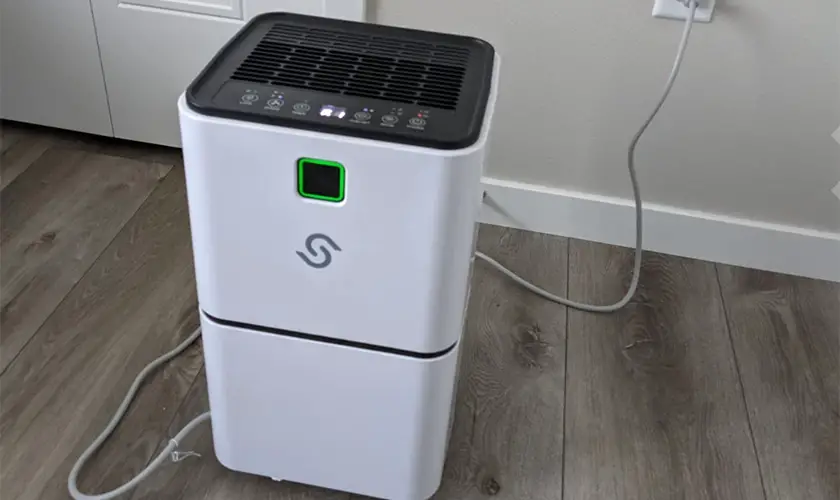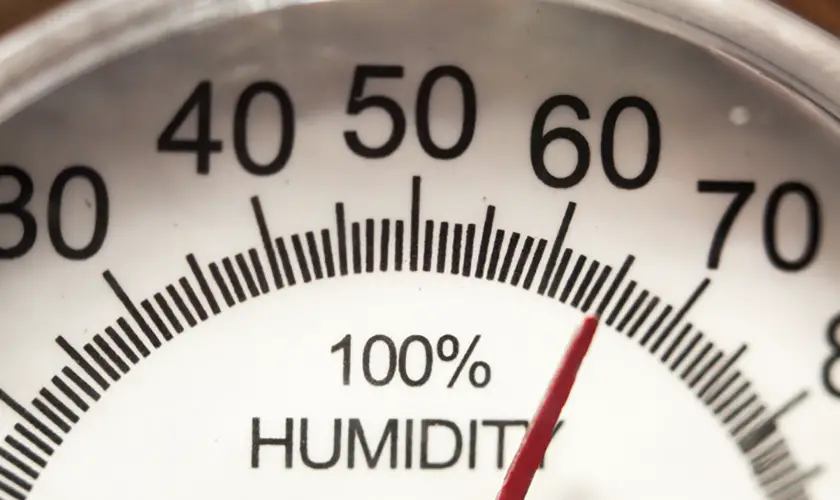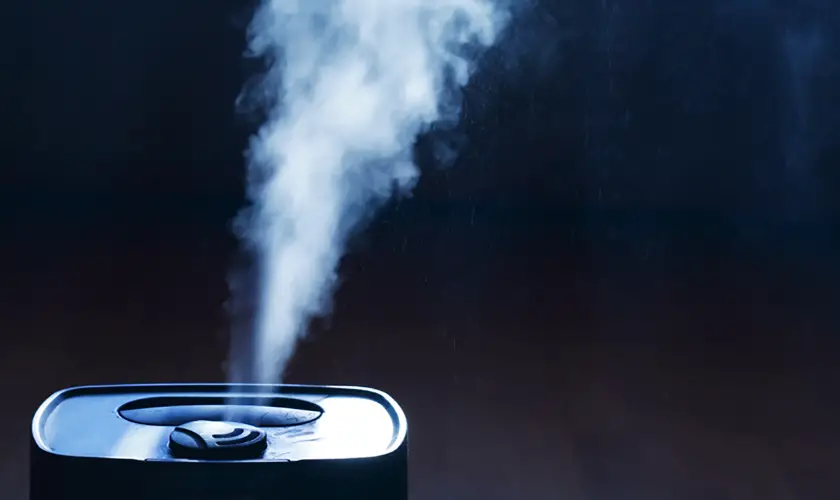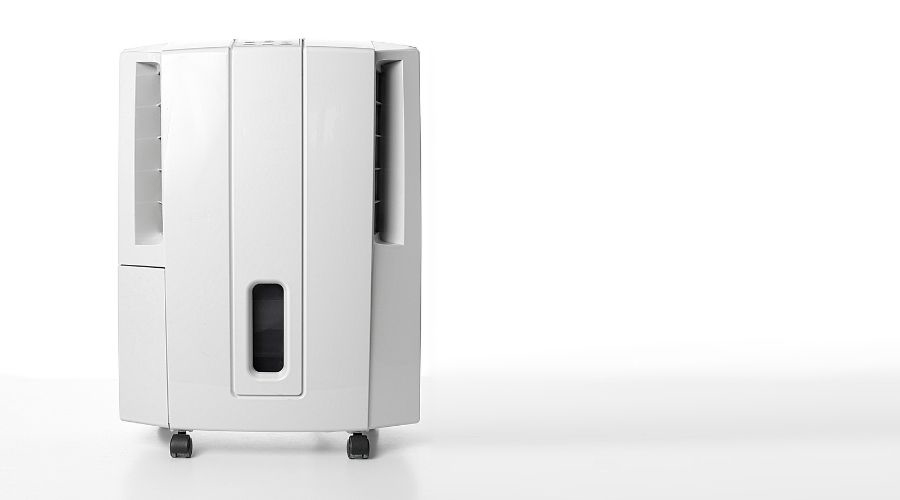
If you use a dehumidifier in your home for health or other reasons, you might notice much water coming from the machine. Water coming out is normal and means that the unit is doing its job correctly. However, one may be wondering, where does dehumidifier water come from?
A dehumidifier works by blowing air over a very cold coil of metal to cause water to condense out. Removing gaseous water from the air creates liquid water, then drained away or stored in a drip pan. The resulting air exiting the unit has less water, reducing your home’s overall humidity.
Whether using a dehumidifier for health reasons, comfort, or to stop mold growth, you will notice the unit produces water. Why it does this and how much it exhibits are covered below. We want to help you make the most of your purchase!
How Does a Dehumidifier Collect Water?
A dehumidifier uses cold temperatures to shift water from a gas to a liquid in condensation. The exact process results in your glass of ice tea collecting droplets of water or blades of grass collecting morning dew.
Recall that a liquid takes energy to transform into a gas. When boiling water, this energy comes in heat from our stovetop and creates steam.
The opposite is also true: if we remove energy from steam, it will become water. Just as we put power in with heat, we take energy out by making things colder.
Inside your dehumidifier is a very cold coil. As air passes over this coil, it loses energy and goes from a gaseous state to liquid. If we continued this cooling process, it would eventually go into a solid-state – ice.
This phase change also affects the area that the water fills by changing its density. The amount of water will take up about 1600 times the space in gas form as liquid, as it is 1600 times less dense.
The condenser coil in your dehumidifier works by compressing refrigerant gas and then allowing it to expand, thus cooling the coils. A similar process is going on in your air conditioner and kitchen freezer.
Next, warm, humid air from your home blows over these coils, which cools them down. When the air cools, two things happen to remove water:
- Water vapor turns to liquid
- The cooler air has less ability to hold water vapor
So, your dehumidifier uses the Ideal Gas Law to cool gas by reducing its pressure, condensing another gas (water vapor), and changing it into liquid water.
All the water you see coming out of the machine has come from the air in your home. Air circulates continuously through the unit, and the relative humidity drops as more water is removed or condensed.
How Much Water Should a Dehumidifier Collect in a Day?
The amount of water your humidifier will collect in a day varies depending on many factors:
- The humidity
- Temperature
- The volume of the room or house
- The size of the dehumidifier unit you have
We must also consider temperature, which plays a significant role in relative humidity. Warmer air can hold more water than cooler air. So, even keeping pressure and moisture levels the same, water will condense if the air is cooled, which is how fog forms.
Anytime we discuss humidity, we also want to be aware of the temperature.
Most units will generally collect about 2 to 5 gallons a day at 85°F and 85% humidity. You can expect less water production if the relative humidity or temperature is less.
The amount removed can also be influenced by how quickly the air changes over in the room and whether or not items in the room are damp.
In a relatively humid room that seals off, the unit will initially collect a high rate of water, but that rate will decrease as the humidity in the room goes down.
For large homes, poorly sealed homes, post-flood remediation, or other situations, you can expect a steady condensation flow from the unit for quite some time. You may need to run the dehumidifier continuously in many hot and humid climates to achieve the desired results.
What is the Ideal Humidity Level for My Home?
The ideal humidity in your home will depend on why you use the dehumidifier. Some common reasons for using one could be:
- Health reasons, including asthma
- Mold or mildew growth in the home
- Dust mite control
- Musty smells
- Flood remediation
- Storage of precious or vulnerable items
We will discuss each case and the ideal humidity below.
1. Dehumidifying for Health Reasons
Some people with asthma, allergies, COPD, and related health issues can find relief from dryer air. Humid air can allow molds and dust mites to thrive, triggering respiratory symptoms.
If someone has advised you to use a dehumidifier for health reasons, you generally want to achieve a relative humidity between 30 to 50%.
2. Dehumidifying to Control Mold and Mildew
Mold and mildew are destructive to your home and your family’s health. While a dehumidifier will not kill mold, it can aid in controlling its growth.
Mold will grow well in warm conditions where the humidity is greater than 60%. The EPA recommends keeping your home’s humidity between 30% and 50% to control mold growth.
3. Dehumidifying to Control Dust Mites
Dust mites feed on dead skin cells, one of the most common sources of allergies in the home. They trigger allergies and coughs and are also the base of the food chain for other insects like mites, silverfish, and even cockroaches.
Dust mites thrive in warm temperatures of about 68 to 77°F and 70 to 80% humidity levels. The American Lung Association recommends keeping humidity levels below 50% to control dust mites in your home,
They also recommend dusting regularly and gleaning carpets and upholstery.
4. Dehumidifying to Clear Musty Smells
Musty-smelling homes usually indicate mold and mildew but can also be other sources such as damp wood and built-up dirt. Either way, musty smells are unpleasant and unwanted.
To rid your house of this problem, follow the same guidelines for mold and mildew, and keep the humidity between 30-50%.
5. Dehumidifier for Flood Remediation
Flood water can wreak havoc on your home, seeping into every porous material and leading to rot, mold, and mildew growth. While we do not recommend using a dehumidifier to remove standing water from the home, it can still dry after a flood.
In this case, you will want to run the dehumidifier at total capacity until all wood, drywall, carpets, and other porous materials are completely dry. In many cases, a single standard residential dehumidifier will not be enough for the job.
It is best to use several dehumidifiers throughout the home or rent a commercial-sized device for larger jobs. Generally, it will take a while to dry out the house thoroughly, so it will have to run anywhere from several days to several weeks.
During that time, the goal is to keep the humidity below 50%, but the lower you get it, the faster everything will dry out, and the less mold or rot will occur.
6. Dehumidifying a Storage Area
Many precious items such as books, paintings, textiles, and even metals are vulnerable to humidity. High humidity can cause these items to rot, develop mildew, or rust.
Everyday use of dehumidifiers reduces the humidity of a storage room or compartment. In the case of safes or cabinets, a chemical desiccant is often used. Essentially this is a larger version of the silica packets that come with some electronics or mediations you buy.
But, a dehumidifier in larger rooms like libraries or art galleries is more practical. In these cases, you will want to keep the humidity levels within these recommended ranges:
- Books: 40-50% humidity at 68-72°F
- Paintings: 40-50% at 70-75°F
- Jewelry: Should be kept a low humidity and a constant temperature
What Can I Do with Dehumidifier Water?
The water from the dehumidifier was just water vapor from the air condensed onto the cold coils inside the unit. However, this water is not clean, as the dehumidifier does not sanitize.
Therefore, you never want to drink this water or allow pets to consume it. The best thing to do is dump it down the drain or toilet.
If you are adamant about reusing it, you can dump it into your garden or use it to water house plants. You can also use it for cleaning or other purposes. Use it anywhere else you would use non-potable water.
What if No Water is Coming out of the Dehumidifier?
1. Check Environmental Conditions
When no water comes from your dehumidifier, first consider the environmental conditions. Recall that the unit works by removing excess water from the air. So, if the air has low relative humidity, the machine will not have anything to get out of.
It can happen when the ambient humidity is low or the house is warming up from a cooler temperature. So consider all the environmental factors and the placement of the unit before assuming something is wrong with it.
2. See if the Machine Still Works
The next thing to check if there is no water from the dehumidifier is whether the machine is working correctly.
Start by resetting the machine. Unplug it and wait about 30 seconds before plugging it back in and starting it up again. Often this will fix the issue. If not, then you may need to check other components.
The components to check include:
- The cooling coil
- Refrigerant
- Capacitor
- Fan
- Control Board
Cooling Coil
Several things can happen to the cooling coil, so start by feeling it to see if it is cool or warm.
Sometimes, they may be covered in ice, so they cannot condense any more water from the air. To fix this, turn the unit off and allow it to defrost before turning it back on.
If your unit has an auto-defrost function, that may not be working and should and could require repair by a service technician.
If the unit seems to be operating correctly, but the coil is not cold, it could be another issue, like the refrigerant or the compressor.
Refrigerant
The refrigerant can leak out, which would stop it from functioning correctly. Like your car’s air conditioner, you can add more refrigerants. However, if there is a significant leak, it may be more costly to fix than purchase a new unit.
Capacitor
The most common reason for the capacitor malfunctioning is extension cords or power strips. Use a new extension cord and run the dehumidifier on its plug rather than a power strip.
The capacitor helps to regulate the electricity coming in. It can be affected by the quality of the power supply. So, if the device works intermittently or powers on and then shuts off again, this is likely why.
Fan
The unit will only remove water from the air if it gets a constant supply of fresh air. Check to ensure the fan is spinning and pulling air through the unit.
If the fan is not spinning, it may either be obstructed or have a broken motor.
Control Board
If you have checked everything above, and it seems that nothing is working, then it could be the control board. It may require professional help and might be pretty costly.
Check online to see if replacement boards are available for your particular unit. If so, you can decide if the cost is worth it or if you should purchase a new machine.
If you have a properly working unit that is the right size for your home, you should see some water from it. If your device does not have one, purchase a humidity gauge for your home so you can track that things are working correctly.
Final Thoughts
When it comes to dehumidifiers, the water is collected by how humid your room is. The more dry air in a room, the less likely you’ll see any liquid coming out of your machine.
So, if you’re trying to buy one for an office or other building with high humidity levels (like bathrooms), you might want to invest in something like this instead.
Remember that these only work when they are left all day, so be sure not to turn them off, especially if it’s winter and cold outside!
Hopefully, this article has answered all your questions and helped optimize your dehumidifier use.






